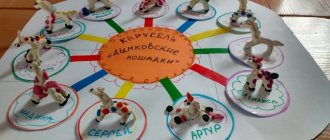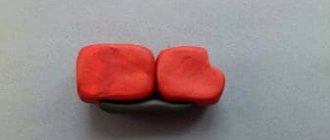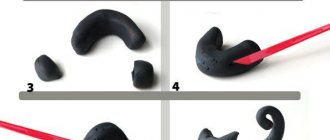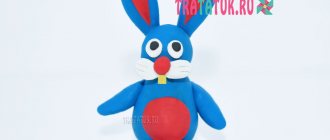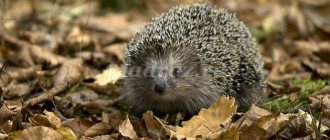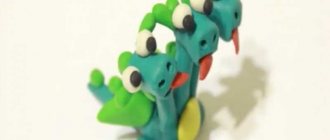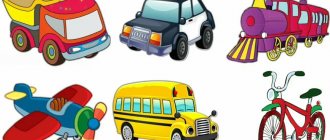Summary of GCD for modeling in the middle group “Grey Bunny”
Notes on modeling "Grey Bunny" in the middle group. Synopsis of GCD for modeling “Grey Bunny” in the middle group. “Health” contributes to the development of an increasingly sustainable interest in the rules of health-preserving and safe behavior, and the development of children’s independence. OO "Physical Culture" continue to form correct posture. OO "Socialization" to develop the ability to participate in collective games and activities, establishing positive relationships based on compliance with basic norms and rules of behavior (not to interfere with each other, if necessary, help, take into account the interests and desires of partners, etc.). NGO "Poznanie" develops children's research activities using simple visual schemes. OO “Artistic Creativity”, in the process of sculpting, consolidate the techniques that the children learned in the previous group; connecting parts by pressing and smearing them (head to body, etc.); arouse interest in decorating sculpted products using stacks. Handouts: plasticine, modeling board, stacks, pink and blue bows, buckwheat eyes, pea nose, fine noodle mustache, yellow, green, blue, red rugs. Demonstration material: soft toy hare, algorithm for performing a bunny Methodological techniques: game situation “a hare came to visit us”, interactive technology “Big Circle” conversation about the hare (body parts, details, encouraging children to take action - “let’s make friends for the hare”, independent activity of children, physical exercise “the little white bunny is sitting...”, visual activity of children, summing up. SOT: health-saving, gender approach, interactive technology. Progress: Children stand around the carpet. Educator: Game situation - Guys, he came to visit us today extraordinary guest. Guess who it is? Loves red carrots, Gnaws cabbage very deftly, He jumps here and there, Through forests and fields, Gray, white and oblique, Who do you think he is? Children: - Bunny. Educator: - Look how wonderful he is. Guys, pay attention to his body parts. What body parts does a hare have? Children: - Torso, head, legs, paws, ears, tail. Educator: - Tell me, what shape is the torso? Head? Legs? Paws? Ears? Tail? Children answer: oval, round. Educator: - Which part of the body is the largest? Children: - Torso. After the body, in size comes the head, then the legs, paws, ears and the smallest part - the tail. Considering the algorithm with children Let's play the game “Big Circle” (interactive technology). Children stand in a circle, passing the bunny, saying what it is. Children: - Agile, fast, long-eared, cowardly, short-tailed. Educator: - Guys, look, our guest came to us alone. Let's make him some friends so he won't be lonely. The teacher offers to go to the board, where the algorithm for performing the bunny is laid out, and they sort out the diagram of where to start. — Guys, tell me how to sculpt the body? Head? Paws? Ears? Tail? Children (with the help of a teacher) - You need to take a stack, break off a piece of plasticine, roll it out with circular movements of your palms to form a ball, then roll out the plasticine into an oval shape with straight movements. - You need to do the head like this: roll out the plasticine in a circular motion into the shape of a ball. — Paws and ears are made by rolling out “sausages.” - For the tail, take the smallest piece of plasticine and roll out a small ball. Educator: - Pay attention. First, the head is attached to the body, then the legs, paws, the ears are attached to the head, then the tail. Each part must be tightly lubricated when connecting. Children sit at tables, the teacher pays attention to the children’s posture. Educator: -But before making a bunny, let’s do finger gymnastics. Deftly from finger to finger. The bunny jumps, the bunny jumps. It rolled down, turned around, and came back again. Again, from finger to finger, the bunny is jumping, the bunny is jumping! Educator: - The bunny will watch, and you will. Let's get down to business. Take a stack and break off a piece of plasticine using the stack. Which body part should you start with? Children: - From the body. (The teacher describes the sculpting process out loud). Educator: - Now let's continue. Which part will you sculpt? Children: - Head. (The teacher describes the sculpting process out loud). Educator: - Let's continue. Which part will you sculpt now? Children: - Paws and legs. (Children sculpt). Educator: - Which part will you take on now? Children: - Ears. (One child describes the sculpting process out loud). Educator: - Well done, everyone can do it. And what's left to create? Children: - Tail. (The teacher, together with the children, describes the sculpting process). Offer the children blue and pink bows; each child must choose whether he made a boy or a girl. The girl (bunny) has a pink bow on her head, the boy (bunny) has a blue bow on her neck. Educator: - You are probably a little tired. Stand near your chairs and follow the movements and words after me. The little white bunny sits and wiggles his ears. Like this, like this, He moves his ears. It’s cold for the bunny to sit, We need to warm our little paws, Like this, like this, We need to warm our little paws. It's cold for the bunny to stand, the bunny needs to jump. Like this, like this, the bunny needs to jump. Reflection. -Did you enjoy sculpting bunnies for your little bunny today? -What good deed did you and I do today? The teacher takes a soft toy: “Our guest really liked the friends you made.” Well done! Now place the bunnies in the clearing.
Summary of a modeling lesson on the topic: “Bunny - long ears”
Program content:
1. Teach children to sculpt a hare from plasticine, conveying the characteristic features: the body is ovoid, the head is a modified ball, the legs are cylinders, the tail is a ball, the ears are flattened cylinders. Use color as desired. 2. Teach children in a combined way. Use the following techniques: roll out the plasticine with circular movements of your hands until you get a ball; roll out the ball with straight hand movements until you get an ovoid; roll out the plasticine with straight movements of your palms until you get cylinders; draw eyes in a stack; Carefully smooth out the joints. 3. Explain the execution of your actions: back and forth, straight movements, cultivate accuracy in work. 4. To instill in children a desire to sculpt, to finish what they have started, and to cultivate accuracy in their work.
Previous work
: modeling cylinders from plasticine with direct hand movements; balls with circular movements of the hands; ovoids, rolling out the balls with straight movements of the hands.
Individual work
: teaches Masha.S., Vanya.F.
do the work independently, without the help of a teacher. Material for the teacher:
bunny - toy, hares - option. Samples from plasticine of different colors; plasticine, board; napkin; stack
Materials for children: plasticine in a set, board /individual/, napkins, stacks.
Progress of the lesson.
The children are sitting at the table. I am reading poetry. Once upon a time there was a bunny with long ears. The bunny's nose froze at the edge of the forest. My nose froze, my tail froze, and I came to warm up and visit the kids. I carry a bunny toy. - Guys, look, a bunny has come to us. -What color is the bunny? What body parts does the hare have? (torso, head, ears, tail, paws). What does the head look like? What about the torso? What shape are the ears and paws? That's right, guys. Do you know why the bunny came to us? He got bored in the forest, he wants to find new bunnie friends. Well, guys, let's help him? Then today we will sculpt bunnies from plasticine. Look how I will do it. I have balls of different sizes prepared in advance: a large ball for the body, a medium one for the head and a small one for the tail. I also made cylinders for the paws and ears. I take a large ball and roll it with straight forward and backward movements of my arms until I get an ovoid. This is the torso. Now I take the middle ball and pull out the muzzle. And now I press the head to the body and smooth it at the junction. Then I take two cylinders and press them to the body - these are the paws, and I also smooth it. And now I take the stack and draw the eyes. So I got a bunny. Guys, where do we start? (Roll out the balls). Show how we roll out the ball (with circular movements of the palms). What about the cylinders? (straight arm movements back and forth). Now, children, take some plasticine and start working. I draw the children's attention to the variable patterns, to the fact that they are of different colors. I remind you how to roll out an ovoid. I distribute cardboard carrots to the children (carrots with the children’s names). -Guys, bring your bunnies to our guest and place them around him. Let him look at your work. Bunny is very happy to make new friends and thanks you. Well done children, everyone did their best. And now the bunny wants to play with you.
Game "Grey Bunny Washes His Face."
